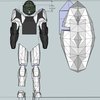3d metal printing currently could use a new strategy for metal 3d printing. Putting metal on substrates and incorporating carbon nano materials is the goal and electroplating makes much more sens and requires very low energy usage compared to lasers and magnetrons using vacuum and plasma sintering. etc.
A conductive bed of silicone will be slung under an x/y cartesion bot. electrolyte will be flowed over the anode or positive lead which is attached to the wire made of the desired plating material. This is the source of positive metal ions in solution. The cathode being the target will be moved by the gantry tool direction and layers will be electroformed upwards.
https://en.wikipedia.org/wiki/Titanium_tetraiodide
Titanium as well as Nickel and Coppper have been successfully electroformed in the past by numerous persons. The most enticing of which is obviously titanium.
Titanium Tetra Iodide can be made by heating Iodide and Titanium Powder the resulting molten salt will dissolve the remainder. The molten salt could provide a high titanium density and higher currents yielding a faster forming process. It would require heating the bed to 80 degrees Celsius and blanketing the molten salt bath with argon and co2.
All fore mention metals have readily available wire for purchasing across the web.
I will be building a bot that can be used to print normally, print batteries, 3d print plastic on a large scale or do electroforming. Different modules could be purchased allowing each functionality.
I believe I can just use my prusa i3 for the parts and build it using some aluminum scrap I have come upon for construction of the gantry which can be mad quite large and custom y axis including the molten salt fiberglass tub.
A couple build plates can provide all the functionaity. Will sketch soon.
This documentation describes Open Hardware and is licensed under the
CERN OHL v. 1.2.
You may redistribute and modify this documentation under the terms of the
CERN OHL v.1.2. (http://ohwr.org/cernohl). This documentation is distributed
WITHOUT ANY EXPRESS OR IMPLIED WARRANTY, INCLUDING OF
MERCHANTABILITY, SATISFACTORY QUALITY AND FITNESS FOR A
PARTICULAR PURPOSE. Please see the CERN OHL v.1.2 for applicable
conditions
 MECHANICUS
MECHANICUS

hey this looks cool, are you going vacuum and magnatron after all?